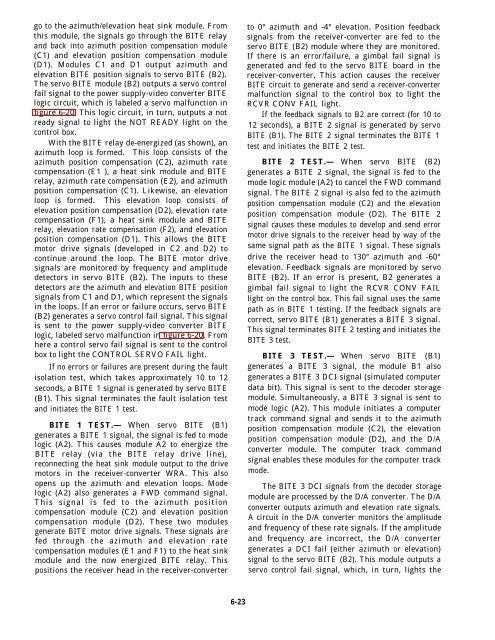Aviation Electronics Technician 1 - Historic Naval Ships Association
Aviation Electronics Technician 1 - Historic Naval Ships Association
Aviation Electronics Technician 1 - Historic Naval Ships Association
You also want an ePaper? Increase the reach of your titles
YUMPU automatically turns print PDFs into web optimized ePapers that Google loves.
go to the azimuth/elevation heat sink module. Fromthis module, the signals go through the BITE relayand back into azimuth position compensation module(C1) and elevation position compensation module(D1). Modules C1 and D1 output azimuth andelevation BITE position signals to servo BITE (B2).The servo BITE module (B2) outputs a servo controlfail signal to the power supply-video converter BITElogic circuit, which is labeled a servo malfunction infigure 6-20. This logic circuit, in turn, outputs a notready signal to light the NOT READY light on thecontrol box.With the BITE relay de-energized (as shown), anazimuth loop is formed. This loop consists of theazimuth position compensation (C2), azimuth ratecompensation (E1 ), a heat sink module and BITErelay, azimuth rate compensation (E2), and azimuthposition compensation (C1). Likewise, an elevationloop is formed. This elevation loop consists ofelevation position compensation (D2), elevation ratecompensation (F1), a heat sink module and BITErelay, elevation rate compensation (F2), and elevationposition compensation (D1). This allows the BITEmotor drive signals (developed in C2 and D2) tocontinue around the loop. The BITE motor drivesignals are monitored by frequency and amplitudedetectors in servo BITE (B2). The inputs to thesedetectors are the azimuth and elevation BITE positionsignals from C1 and D1, which represent the signalsin the loops. If an error or failure occurs, servo BITE(B2) generates a servo control fail signal. This signalis sent to the power supply-video converter BITElogic, labeled servo malfunction in figure 6-20. Fromhere a control servo fail signal is sent to the controlbox to light the CONTROL SERVO FAIL light.If no errors or failures are present during the faultisolation test, which takes approximately 10 to 12seconds, a BITE 1 signal is generated by servo BITE(B1). This signal terminates the fault isolation testand initiates the BITE 1 test.BITE 1 TEST.— When servo BITE (B1)generates a BITE 1 signal, the signal is fed to modelogic (A2). This causes module A2 to energize theBITE relay (via the BITE relay drive line),reconnecting the heat sink module output to the drivemotors in the receiver-converter WRA. This alsoopens up the azimuth and elevation loops. Modelogic (A2) also generates a FWD command signal.This signal is fed to the azimuth positioncompensation module (C2) and elevation positioncompensation module (D2). These two modulesgenerate BITE motor drive signals. These signals arefed through the azimuth and elevation ratecompensation modules (E1 and F1) to the heat sinkmodule and the now energized BITE relay. Thispositions the receiver head in the receiver-converterto 0° azimuth and -4° elevation. Position feedbacksignals from the receiver-converter are fed to theservo BITE (B2) module where they are monitored.If there is an error/failure, a gimbal fail signal isgenerated and fed to the servo BITE board in thereceiver-converter. This action causes the receiverBITE circuit to generate and send a receiver-convertermalfunction signal to the control box to light theRCVR CONV FAIL light.If the feedback signals to B2 are correct (for 10 to12 seconds), a BITE 2 signal is generated by servoBITE (B1). The BITE 2 signal terminates the BITE 1test and initiates the BITE 2 test.BITE 2 TEST.— When servo BITE (B2)generates a BITE 2 signal, the signal is fed to themode logic module (A2) to cancel the FWD commandsignal. The BITE 2 signal is also fed to the azimuthposition compensation module (C2) and the elevationposition compensation module (D2). The BITE 2signal causes these modules to develop and send errormotor drive signals to the receiver head by way of thesame signal path as the BITE 1 signal. These signalsdrive the receiver head to 130° azimuth and -60°elevation. Feedback signals are monitored by servoBITE (B2). If an error is present, B2 generates agimbal fail signal to light the RCVR CONV FAILlight on the control box. This fail signal uses the samepath as in BITE 1 testing. If the feedback signals arecorrect, servo BITE (B1) generates a BITE 3 signal.This signal terminates BITE 2 testing and initiates theBITE 3 test.BITE 3 TEST.— When servo BITE (B1)generates a BITE 3 signal, the module B1 alsogenerates a BITE 3 DCI signal (simulated computerdata bit). This signal is sent to the decoder storagemodule. Simultaneously, a BITE 3 signal is sent tomode logic (A2). This module initiates a computertrack command signal and sends it to the azimuthposition compensation module (C2), the elevationposition compensation module (D2), and the D/Aconverter module. The computer track commandsignal enables these modules for the computer trackmode.The BITE 3 DCI signals from the decoder storagemodule are processed by the D/A converter. The D/Aconverter outputs azimuth and elevation rate signals.A circuit in the D/A converter monitors the amplitudeand frequency of these rate signals. If the amplitudeand frequency are incorrect, the D/A convertergenerates a DCI fail (either azimuth or elevation)signal to the servo BITE (B2). This module outputs aservo control fail signal, which, in turn, lights the6-23
















